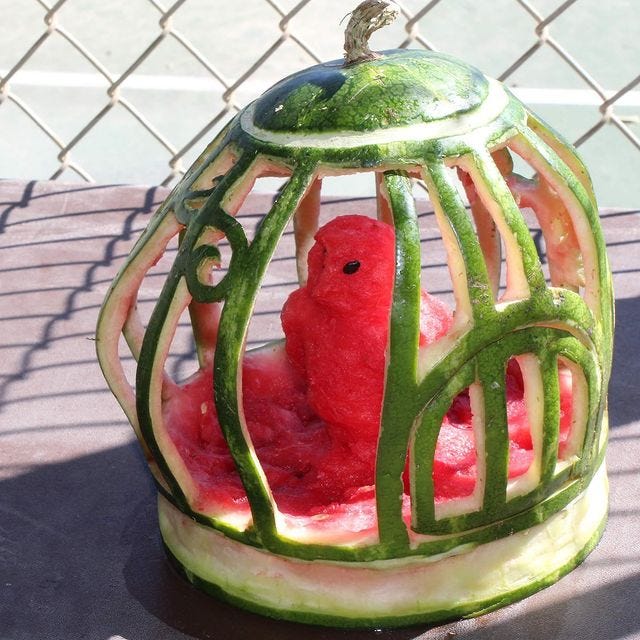Placeful is a weekly newsletter exploring sense of place, sustainability, and the actions we can take to more deeply engage with our communities and wild spaces. Each week covers a new topic. To learn more about the “why” behind Placeful, start here.
As an avid hiker, I like to think about placefulness as a large trail system. From a central location (a desire to connect to place), we can hop on many different trails, leading to many meaningful experiences, but only if we put in the time, effort, and intention.
In my mind, food is one of the largest trail networks in this proverbial system. Food can connect us to place, to people, to history, and to land. Most importantly of all, eating is something we have to do everyday, giving us ample opportunity to practice placefulness while nourishing our bodies.
Today, I’d like to introduce the concept of Community Supported Agriculture, one small but growing piece of the food network (not the TV channel!). I’ll explain in more detail what exactly it is, how it works, and how participating can bring us closer to our goal of placefulness.
What is Community Supported Agriculture?
Community Supported Agriculture, often shortened to CSA, is a model of direct-to-consumer marketing of produce, eggs, meat, or other value-added goods. The CSA model is often used by small to mid-sized farms. CSA customers—or members—typically purchase a share at the beginning of the season and receive produce from the farm for a predetermined period of time, typically on a weekly or biweekly basis. Shares can vary in cost depending on size of household, frequency of pick-up or delivery, and cost-of-living in your area. At the garden-based education nonprofit where I work, a biweekly share costs $225 and runs May - October; members typically receive more produce in value than what they paid up front.
The CSA model works as a partnership between growers and consumers. By paying up front, CSA members share in the risks of farming (such as the failure of a particular crop), but also are assured that they will receive fresh, local produce all season long. Because the farmer receives the investment up front, they are able to put it back into the farm through purchases of seeds, tools, and other equipment, or by hiring additional staff to assist with production, processing, and distribution.
CSA models of agriculture were originally pioneered by Black farmers back in the 1960’s and 70’s and have become more popularized in recent years. Some farms operate solely using the Communitiy Supported Agriculture model. According to the USDA, there were 7,398 U.S. farms utilizing the CSA model in 2015, and I speculate that this number has only grown since then.
Earlier this year, Civil Eats reported that CSA memberships were surging amidst the pandemic. People were (and still are) rightfully scared of how our global food economy could be affected. Investing in a CSA is one way that people feel more secure in a sea of uncertainty. And as for growers, many farms that had previously not tried a CSA made a quick pivot to cover losses from restaurant sales or other pandemic-affected marketing channels.
For these reasons and more, there has never been a better time to consider purchasing a 2021 Community Supported Agriculture share. Curious to see if there is one in your area? Here is one place you can start looking.
CSA membership & placefulness
When we become members of a CSA, we literally become part of a community. We join likedminded people in the pursuit of growing and eating delicious local produce, without necessarily having to do the work of growing it ourselves. Below are a few reasons why I think CSA’s are a tangible and fun way to connect to place.
CSAs connect us with the change of seasons
Lest we let all of the beautiful produce in our CSA shares go bad, we are challenged to cook, eat, or share from the seasonal bounty of the farm. Too many tomatoes to eat in one week? A great time to learn how to can pasta sauce! Overwhelmed with zucchini? Try out some new baking recipes! Eating seasonally connects us with food plants that thrive locally, and the cycles of their growth, maturity, and eventual decay.
CSAs introduce us to diverse, locally-adapted food crops
How amazing is it that we have such a delicious diversity of crops to nourish us? For that, we can thank indigenous farmers across the world, who over time domesticated an estimated 60% of the crops that we grow today.
According to Wikipedia, there are over 10,000 cultivars—or different varieties—of tomatoes. Truly astounding! We certainly would not deduce this breadth of diversity from what is available to us at supermarkets.
Just as animals have adaptations that allow them to thrive in different places, through seed saving, farmers and gardeners develop fruit, vegetable, and herb varieties that are adapted to local conditions. Though not guaranteed, it is likely that our CSA shares include produce varities that are locally adapted, whose seeds may have been saved and passed on through generations of local growers.
When we eat these foods, we connect with our community’s agricultural history, with the knowledge that these seeds were saved not just for their adaptive potential, but also because these varieties have been enjoyed and shared between people for many years. Sentiments like this are how festivals celebrating local crops are born, such as the Melon Days Festival in Green River, Utah.
CSA work trades connect us with likeminded community members
Many Community Supported Agriculture farms have work-trade programs, where people can come work on the farm for a certain number of hours for a discounted share, or some variation on that idea that benefits both parties.
For people who do not have hands-on experience with gardening or agricultural, work trades are a great way to learn about where our food comes from and connect us with the food system—something we rely on directly each and every day. Additionally, work-trade programs are a great way to meet other people who may share our values, thereby expanding our social connections to place at the same time.
CSAs give us a reason to gather
During the height of the growing season, a CSA share may contain more food than we could possibly eat fresh. Rather than thinking about this as a problem, consider it a gift that allows us to connect with others. A few options include:
Donating excess produce to people experiencing food insecurity—some food banks and other organizations accept and appreciate donations of fresh food
Hosting a gathering (when it is safe) to share the abundance and connect with family, friends, and neighbors
Reaching out to someone in your community to learn about food preservation—canning, jamming, and fermentation are all delicious ways to reap the benefits of an abundant growing season for many months
Celebrate food all the time, not just once a year
The food system is one example among many of something that has been globalized, but can be local if we support it. There are benefits to both, but for the purposes of connecting to place, I encourage everyone to see what opportunities exist for connecting with the local food community. CSA membership is one clear way to do this, but there are so many others that I look forward to exploring with you all in future issues of Placeful.
Of the many proverbial trails we can take to explore the places we live, the one traversing food and agriculture is expansive, beautiful, and open to all.
With love,
Emily
Placeful Practice
Explore the website localharvest.org or do a quick internet search to see if joining a Community Supported Agriculture program is possible in your local area. Reach out now about joining in 2021. Some farms may have waitlists, so now is a good time to research!
Side note: I know that joining a CSA is not necessarily affordable for everyone—this was the case for me for many years. CSA farmers might be willing to help out if you start a conversation. Is there a work-trade available? Do they offer a student or senior discount?
If a CSA is not a possiblity for any reason, what other ways are available—beyond joining a CSA—to connect with place through food and agriculture? I’m always happy to chat about this and think about it all the time as part of my full-time job at a garden-based education nonprofit; feel free to send me an email at placeful.emily@gmail.com or leave a comment!
Giving Tuesday is December 1st!
As a nonprofit development professional, I would be remiss not to mention that December 1st is #GivingTuesday. It might go by another name in your state, but no matter where you are, Giving Tuesday is great opportunity for us to collectively show some gratitude to the organizations that are making our communities great places to live, work, and play.
For many nonprofits, individual contributions are an important part of their funding strategy. And less time spent applying for grants and seeking other funding opportunities equals more time for doing the work! $5 or $500, any amount makes a difference y’all. Here’s a cut from the official Giving Tuesday website that shows how it fits snuggly into the mission of Placeful, too:
In an era of global crisis and disconnection, we need new rituals to connect us . . . GivingTuesday strives to build a world in which the catalytic power of generosity is at the heart of the society we build together, unlocking dignity, opportunity and equity around the globe. We believe that generosity leads to greater civic participation and other pro-social behaviors.
How are you giving back to your community on Giving Tuesday?
Placeful is a weekly email newsletter containing personal narratives and reporting on sense of place and sustainability. Each week I delve into a new topic, wrapping it up with an action item that will help readers foster deeper connections to the natural, cultural, built, and historic environments around them. Read more about Placeful.
To find a web version of this issue, click here. Know someone who would appreciate the topics I’m writing about? Please share! And lastly, if someone forwarded this to you, subscribe below to receive future issues straight to your inbox. Thanks for reading <3






